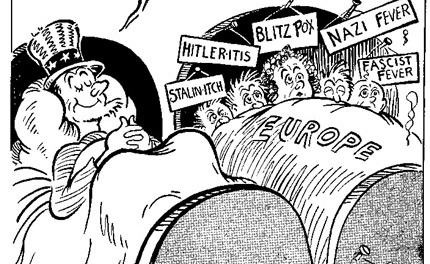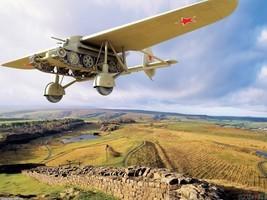The Soviet Tank that Saved the US Tank Industry
In the early 1930's, the US was in the throes of the Great Depression. Military spending was a bare minimum. Many in Congress and a majority in the US State Department felt that the arms trade had dragged the US into the Great War. They were determined to prevent this from happening again.
However, the visionary (or eccentric, depending on your outlook) tank designer by the name of Walter Christie needed support to continue development of his design work for the US Army. Christie's designs found little reception in the US, but the overall arc of armor design and doctrine work in the US Army was dependent on a stable of new ideas--and Christie was definitely part of that picture.
Christie is most known for his suspension, which involved spring coils which act as shock absorbers for independent (or sometimes tandem) road wheels. These coils needed protection, not only from battle damage but from mud and dirt. In practice, most designs involved keeping the steel coils on the inside of the vehicle for added protection. This, however, took up crew space. It also allowed for unparalleled cross country speeds. The Christie suspension became an important part of tank design in the 1930's.
The Christie suspension applied on the T-34.
Early on, Christie recognized that a major problem with tanks was Operational Mobility. Tanks generally had a road range of about 200 miles before requiring major maintenance. A lot of this maintenance had to do with the drive train. In order to take stress off of the drive train, Christie developed a plan whereby the tracks were removed and the tank could travel on its rubberized road wheels. This allowed even faster road travel.
The Soviet Union found out about Christie's work through the US press. The Soviet Union did not, at this time, have diplomatic relations with the US, but the Amtorg office in New York represented its commercial interests. After Poland visited Christie's design headquarters, the Soviets were concerned and also arranged a visit. While not interested in the technology itself, the US was loathe to allow it to be transferred to the Soviets and, even as US arms sales began to loosen up, the deal was never done.
However, by 1930, Christie had worked out a deal with Amtorg for $60,000 for two tanks and $100,000 for the license to produce the Christie tank in the Soviet Union. There was a bit of shenanigans that went on, as Christie stressed to the State Department that the units were for agriculture. Indeed, the Christie M1928's were shipped to the Soviet Union without turrets, a fact which caused some severe problems with the buyers and eventually led to a $25,000 rebate.
Additionally, the Soviets had dozens of engineers touring and working in the Christie plant in order to learn what would be needed to set up the plants in the Soviet Union. There is little doubt that the Soviet Union got a tremendous boost in tank technology from Christie and this small contract. This led to the BT-5. BT-7, the A-32 and later the T-34.
The State Department was livid with the deal and tried to have the deal cancelled, but it was after the prototypes had shipped (without the turrets) and the deal went through as signed.
Far from being a product of a spy-ring, however, the Christie deal had been spurred on by the US Army tank development office, which saw a chance to keep US tank developers in business through the depression without actually spending US funds. While Christie's designs were perhaps a bit over the top--the Soviet Union also purchased plans for Christie's models which used the tank engine to drive a propeller for a tank-plane and a pontoon system which allowed it to float over rivers and water obstacles--his suspension and armor slope ideas were not only avant-garde but quite revolutionary in tank design. Keeping him open was important for the US military.
It's quite interesting to look back on the days when military spending was so spare that we relied on other countries' militaries for research and development. It's also interesting to think that a US engineer could have played such an important role in Soviet tank development.
Even though the BT-series tanks have a very good ASL reputation, there were a large number of innovations that they contained. They were fast, included a two-man turret and a rather decent 40mm anti-tank gun. While it didn't have a turret basket, it did have seats that were attached to the turret that allowed the crew to pivot with the turret and not have to stumble around. It had a remarkable HP to weight ratio--even though its engines were considered very bad.
However, it does make sense to remember that most of the BT's that faced the Germans during Barbarossa were worn out and/or needed refurbishment or spare parts. Some were around 10 years old (ancient for tanks) and overall, they either lacked radios, had radios in command tanks that were easily identifiable from outside and that the tank radios of the Soviet Union built during this time were very, very fragile. If your tank took a hit, if you were lucky enough to survive, it was likely that your radio was out of action after the jolt.
Mainly, however, BTs were the victim of poor tactics and poor doctrine in ways that are not easily simulated in ASL.
So we should provide a round of applause for the Soviet tank that kept American tank development flourishing, rather than going under in the weight of the great depression: Walter Christie's BT series....
However, the visionary (or eccentric, depending on your outlook) tank designer by the name of Walter Christie needed support to continue development of his design work for the US Army. Christie's designs found little reception in the US, but the overall arc of armor design and doctrine work in the US Army was dependent on a stable of new ideas--and Christie was definitely part of that picture.
Christie is most known for his suspension, which involved spring coils which act as shock absorbers for independent (or sometimes tandem) road wheels. These coils needed protection, not only from battle damage but from mud and dirt. In practice, most designs involved keeping the steel coils on the inside of the vehicle for added protection. This, however, took up crew space. It also allowed for unparalleled cross country speeds. The Christie suspension became an important part of tank design in the 1930's.
The Christie suspension applied on the T-34.
Early on, Christie recognized that a major problem with tanks was Operational Mobility. Tanks generally had a road range of about 200 miles before requiring major maintenance. A lot of this maintenance had to do with the drive train. In order to take stress off of the drive train, Christie developed a plan whereby the tracks were removed and the tank could travel on its rubberized road wheels. This allowed even faster road travel.
The Soviet Union found out about Christie's work through the US press. The Soviet Union did not, at this time, have diplomatic relations with the US, but the Amtorg office in New York represented its commercial interests. After Poland visited Christie's design headquarters, the Soviets were concerned and also arranged a visit. While not interested in the technology itself, the US was loathe to allow it to be transferred to the Soviets and, even as US arms sales began to loosen up, the deal was never done.
However, by 1930, Christie had worked out a deal with Amtorg for $60,000 for two tanks and $100,000 for the license to produce the Christie tank in the Soviet Union. There was a bit of shenanigans that went on, as Christie stressed to the State Department that the units were for agriculture. Indeed, the Christie M1928's were shipped to the Soviet Union without turrets, a fact which caused some severe problems with the buyers and eventually led to a $25,000 rebate.
Additionally, the Soviets had dozens of engineers touring and working in the Christie plant in order to learn what would be needed to set up the plants in the Soviet Union. There is little doubt that the Soviet Union got a tremendous boost in tank technology from Christie and this small contract. This led to the BT-5. BT-7, the A-32 and later the T-34.
The State Department was livid with the deal and tried to have the deal cancelled, but it was after the prototypes had shipped (without the turrets) and the deal went through as signed.
Far from being a product of a spy-ring, however, the Christie deal had been spurred on by the US Army tank development office, which saw a chance to keep US tank developers in business through the depression without actually spending US funds. While Christie's designs were perhaps a bit over the top--the Soviet Union also purchased plans for Christie's models which used the tank engine to drive a propeller for a tank-plane and a pontoon system which allowed it to float over rivers and water obstacles--his suspension and armor slope ideas were not only avant-garde but quite revolutionary in tank design. Keeping him open was important for the US military.
It's quite interesting to look back on the days when military spending was so spare that we relied on other countries' militaries for research and development. It's also interesting to think that a US engineer could have played such an important role in Soviet tank development.
Even though the BT-series tanks have a very good ASL reputation, there were a large number of innovations that they contained. They were fast, included a two-man turret and a rather decent 40mm anti-tank gun. While it didn't have a turret basket, it did have seats that were attached to the turret that allowed the crew to pivot with the turret and not have to stumble around. It had a remarkable HP to weight ratio--even though its engines were considered very bad.
However, it does make sense to remember that most of the BT's that faced the Germans during Barbarossa were worn out and/or needed refurbishment or spare parts. Some were around 10 years old (ancient for tanks) and overall, they either lacked radios, had radios in command tanks that were easily identifiable from outside and that the tank radios of the Soviet Union built during this time were very, very fragile. If your tank took a hit, if you were lucky enough to survive, it was likely that your radio was out of action after the jolt.
Mainly, however, BTs were the victim of poor tactics and poor doctrine in ways that are not easily simulated in ASL.
So we should provide a round of applause for the Soviet tank that kept American tank development flourishing, rather than going under in the weight of the great depression: Walter Christie's BT series....







Comments